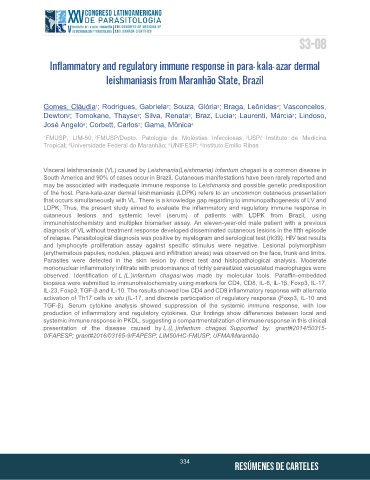Page 336 - Resúmen - XXV Congreso Latinoamericano de Parasitología - FLAP
P. 336
S3-08
Inflammatory and regulatory immune response in para- kala- azar dermal
leishmaniasis from Maranhão State, Brazil
Gomes, Cláudia ; Rodrigues, Gabriela ; Souza, Glória ; Braga, Leônidas ; Vasconcelos,
1
2
3
4
Dewton ; Tomokane, Thayse ; Silva, Renata ; Braz, Lucia ; Laurenti, Márcia ; Lindoso,
2
2
5
3
2
José Angelo ; Corbett, Carlos ; Gama, Mônica
2
6
4
1 FMUSP, LIM-50; FMUSP/Depto. Patologia de Moléstias Infecciosas; USP/ Instituto de Medicina
3
2
Tropical; Universidade Federal do Maranhão; UNIFESP; Instituto Emilio Ribas
4
6
5
Visceral leishmaniasis (VL) caused by Leishmania(Leishmania) infantum chagasi is a common disease in
South America and 90% of cases occur in Brazil. Cutaneous manifestations have been rarely reported and
may be associated with inadequate immune response to Leishmania and possible genetic predisposition
of the host. Para-kala-azar dermal leishmaniasis (LDPK) refers to an uncommon cutaneous presentation
that occurs simultaneously with VL. There is a knowledge gap regarding to immunopathogenesis of LV and
LDPK; Thus, the present study aimed to evaluate the inflammatory and regulatory immune response in
cutaneous lesions and systemic level (serum) of patients with LDPK from Brazil, using
immunohistochemistry and multiplex biomarker assay. An eleven-year-old male patient with a previous
diagnosis of VL without treatment response developed disseminated cutaneous lesions in the fifth episode
of relapse. Parasitological diagnosis was positive by myelogram and serological test (rk39). HIV test results
and lymphocyte proliferation assay against specific stimulus were negative. Lesional polymorphism
(erythematous papules, nodules, plaques and infiltration areas) was observed on the face, trunk and limbs.
Parasites were detected in the skin lesion by direct test and histopathological analysis. Moderate
mononuclear inflammatory infiltrate with predominance of richly parasitized vacuolated macrophages were
observed. Identification of L.(L.)infantum chagasi was made by molecular tools. Paraffin-embedded
biopsies were submitted to immunohistochemistry using markers for CD4, CD8, IL-6, IL-1β, Foxp3, IL-17,
IL-23, Foxp3; TGF-β and IL-10. The results showed low CD4 and CD8 inflammatory response with alternate
activation of Th17 cells in situ (IL-17, and discrete participation of regulatory response (Foxp3, IL-10 and
TGF-β). Serum cytokine analysis showed suppression of the systemic immune response, with low
production of inflammatory and regulatory cytokines. Our findings show differences between local and
systemic immune response in PKDL, suggesting a compartmentalization of immune response in this clinical
presentation of the disease caused by L.(L.)infantum chagasi. Supported by: grant#2014/50315-
0/FAPESP; grant#2016/03165-9/FAPESP; LIM50/HC-FMUSP; UFMA/Maranhão
334
RESÚMENES DE CARTELES

